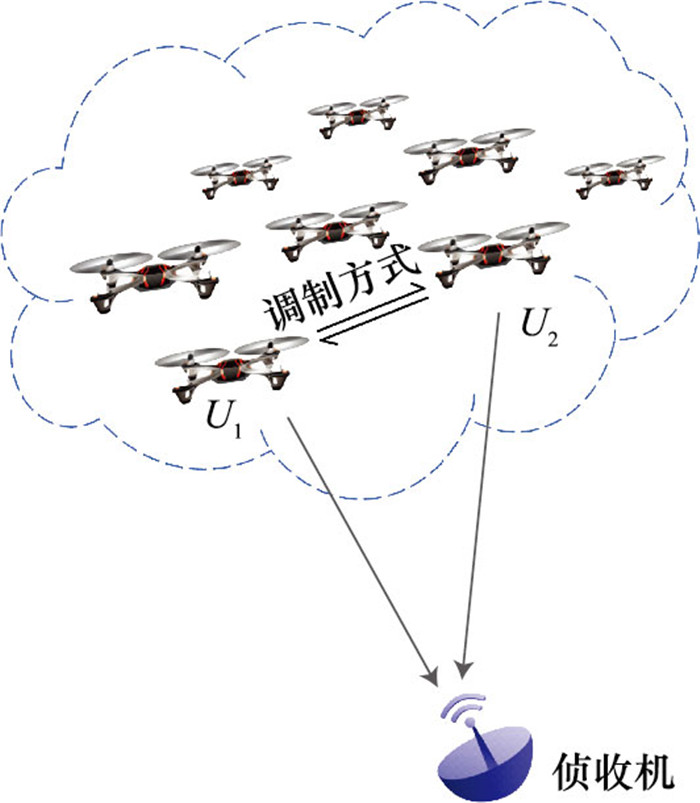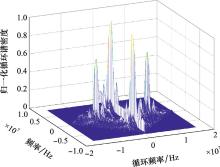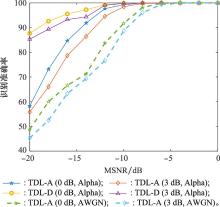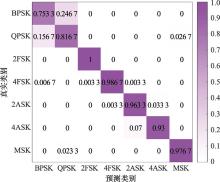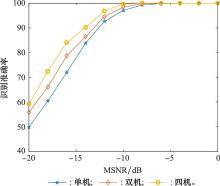Systems Engineering and Electronics ›› 2023, Vol. 45 ›› Issue (10): 3312-3320.doi: 10.12305/j.issn.1001-506X.2023.10.36
• Communications and Networks • Previous Articles
Waveform recognition of unmanned aerial vehicle swarm communication in complex multipath environment
Ruping ZHAI, Shuheng ZHANG, Jiarong PING
- School of Electronics and Information Engineering, Nanjing University of Aeronautics and Astronautics, Nanjing 210016, China
-
Received:2022-08-10Online:2023-09-25Published:2023-10-11 -
Contact:Ruping ZHAI
CLC Number:
Cite this article
Ruping ZHAI, Shuheng ZHANG, Jiarong PING. Waveform recognition of unmanned aerial vehicle swarm communication in complex multipath environment[J]. Systems Engineering and Electronics, 2023, 45(10): 3312-3320.
share this article
| 1 | 柳征, 王明阳, 姜文利, 等. 一种新的贝叶斯调制分类算法[J]. 电子与信息学报, 2006, 7, 1233- 1237. |
| LIU Z , WANG M Y , JIANG W L , et al. A novel Bayesian modulation classification algorithm[J]. Journal of Electronics and Information, 2006, 7, 1233- 1237. | |
| 2 | 李红光, 郭英, 眭萍, 等. 基于时频能量谱纹理特征的跳频调制方式识别[J]. 通信学报, 2019, 40 (10): 20- 29. |
| LI H G , GUO Y , SUI P , et al. Identification of frequency hopping modulation mode based on time-frequency energy spectrum texture features[J]. Journal of Communications, 2019, 40 (10): 20- 29. | |
| 3 |
KUMAR Y , SHEORAN M , JAJOO G , et al. Automatic modulation classification based on constellation density using deep learning[J]. IEEE Communications Letters, 2020, 24 (6): 1275- 1278.
doi: 10.1109/LCOMM.2020.2980840 |
| 4 | XIE W W , HU S , YU C , et al. Deep learning in digital modulation recognition using high order cumulants[J]. IEEE Access, 2019, 63760- 63766. |
| 5 | 郝云飞. 基于深度学习的无人机信号检测与识别技术研究[D]. 长沙: 国防科技大学, 2019: 42-56. |
| HAO Y F. Research on detection and recognition technology for UAV signal based on deep learning[D]. Changsha: National University of Defense Technology, 2019: 42-56. | |
| 6 | 王自维, 姚志成, 王海洋, 等. 基于改进LeNet-5模型的无人机遥控信号调制方式识别算法[J]. 火箭军工程大学学报, 2021, 4, 30- 34. |
| WANG Z W , YAO Z C , WANG H Y , et al. Recognition algorithm of UAV remote control signal modulation mode based on improved LeNet-5 model[J]. Journal of Rocket Force Engineering University, 2021, 4, 30- 34. | |
| 7 |
TU Y , LIN Y . Deep neural network compression technique towards efficient digital signal modulation recognition in edge device[J]. IEEE Access, 2019, 7, 58113- 58119.
doi: 10.1109/ACCESS.2019.2913945 |
| 8 |
WANG D , ZHANG M , LI Z , et al. Modulation format recognition and OSNR estimation using CNN-based deep learning[J]. IEEE Photonics Technology Letters, 2017, 29 (19): 1667- 1670.
doi: 10.1109/LPT.2017.2742553 |
| 9 |
ZHANG Z F , WANG C , GAN C Q , et al. Automatic modulation classification using convolutional neural network with features fusion of SPWVD and BJD[J]. IEEE Trans.on Signal and Information Processing Over Networks, 2019, 5 (3): 469- 478.
doi: 10.1109/TSIPN.2019.2900201 |
| 10 | 张天骐, 范聪聪, 葛宛营, 等. 基于ICA和特征提取的MIMO信号调制识别算法[J]. 电子与信息学报, 2020, 42 (9): 2208- 2215. |
| ZHANG T Q , FAN C C , GE W Y , et al. A modulation identification algorithm of MIMO signal based on ICA and feature extraction[J]. Journal of Electronics and Information, 2020, 42 (9): 2208- 2215. | |
| 11 | PENG S L , JIANG H Y , WANG H X , et al. Modulation classification based on signal constellation diagrams and deep learning[J]. IEEE Trans.on Neural Networks and Learning Systems, 2018, 30 (3): 718- 727. |
| 12 | 张思成, 林云, 涂涯, 等. 基于轻量级深度神经网络的电磁信号调制识别技术[J]. 通信学报, 2020, 41 (11): 12- 21. |
| ZHANG S C , LIN Y , TU Y , et al. Electromagnetic signal modulation identification technology based on lightweight deep neural network[J]. Journal of Communications, 2020, 41 (11): 12- 21. | |
| 13 | 李晨, 杨俊安, 刘辉. 基于信息熵和GA-ELM的调制识别算法[J]. 系统工程与电子技术, 2020, 42 (1): 223- 229. |
| LI C , YANG J A , LIU H . Modulation identification algorithm based on information entropy and GA-ELM[J]. Systems Engineering and Electronics, 2020, 42 (1): 223- 229. | |
| 14 | 史蕴豪, 许华, 郑万泽, 等. 基于集成学习与特征降维的小样本调制识别方法[J]. 系统工程与电子技术, 2021, 43 (4): 1099- 1109. |
| SHI Y H , XU H , ZHENG W Z , et al. Few-sample modulation recognition method based on ensemble learning and feature dimensionality reduction[J]. Systems Engineering and Electro-nics, 2021, 43 (4): 1099- 1109. | |
| 15 | 冯径, 熊鑫立, 蒋磊. 软件通信适配器的调制模式识别算法[J]. 东南大学学报, 2017, 47 (3): 456- 460. |
| FENG J , XIONG X L , JIANG L . Modulation pattern recognition algorithm for software communication adapter[J]. Journal of Southeast University, 2017, 47 (3): 456- 460. | |
| 16 | ETSI TR 38.901. Study on channel model for frequencies from 0.5 to 100 GHz (V17.0.0)[S]. 3GPP, 2022. |
| 17 | JAKES W C . Microwave mobile communications[M]. New York: Wiley, 1974. |
| 18 | SAMORODNITSKY G , TAQQU M S . Stable non-Gaussian random processes: stochastic models with infinite variance[M]. London: Routledge, 2017. |
| 19 | AZZOUZ E , NANDI A K . Automatic modulation recognition of communication signals[M]. BerLin: Springer Science & Business Media, 2013. |
| 20 | 孔豫京. 基于Alpha稳定分布理论的无人机侦察信道建模与信号调制识别技术研究[D]. 郑州: 解放军信息工程大学, 2015: 52-53. |
| KONG Y J. Research on channel modeling and signal modulation recognition for UAV reconnaissance based on Alpha stable distribution theory[D]. Zhengzhou: PLA Information Engineering University, 2015: 52-53. | |
| 21 | ALI A , YANG Y F . Automatic modulation classification using deep learning based on sparse autoencoders with nonnegativity constraints[J]. IEEE Signal Processing Letters, 2017, 24 (11): 1626- 1630. |
| [1] | Xiaogang QI, Yutong ZHOU, Lifang LIU. Evaluation of the reliability of UAV swarm for ground combat missions [J]. Systems Engineering and Electronics, 2023, 45(9): 2971-2978. |
| [2] | Pei GONG, Tianyun LI, Xinliang ZHANG, Chentao CUN. Modulation recognition for satellite single-mixed signals using joint characteristic parameters [J]. Systems Engineering and Electronics, 2023, 45(2): 589-596. |
| [3] | Bowei QIN, Lei JIANG, Hua XU, Zisen QI. Modulation recognition algorithm based on residual generation adversarial network [J]. Systems Engineering and Electronics, 2022, 44(6): 2019-2026. |
| [4] | Xuping GU, Daquan TANG. Hierarchical cooperative navigation of UAV swarm based on federated filtering algorithm [J]. Systems Engineering and Electronics, 2022, 44(3): 967-976. |
| [5] | Kai SHAO, Miaomiao ZHU, Guangyu WANG. Modulation recognition method based on generative adversarial andconvolutional neural network [J]. Systems Engineering and Electronics, 2022, 44(3): 1036-1043. |
| [6] | Xingjia YANG, Keqing DUAN, Xiang LI, Wei QI. Resolving range ambiguity for cooperative detection using UAV swarms [J]. Systems Engineering and Electronics, 2022, 44(2): 480-489. |
| [7] | Xiaowei FU, Jing PAN. Distributed formation control of UAV swarm with dynamic obstacle avoidance [J]. Systems Engineering and Electronics, 2022, 44(2): 529-537. |
| [8] | Yunhao SHI, Hua XU, Wanze ZHENG, Yinghui LIU. Few-shot modulation recognition method based on ensemble learning and feature dimension reduction [J]. Systems Engineering and Electronics, 2021, 43(4): 1099-1109. |
| [9] | Zihao SONG, Wei CHENG, Cenxin PENG, Xiaobai LI. Modulation recognition method based on CWD and residual shrinkage network [J]. Systems Engineering and Electronics, 2021, 43(11): 3371-3379. |
| [10] | Kai LIU, Bin ZHANG, Qinghua HUANG. Modulation recognition algorithm based on TCNN-BiLSTM [J]. Systems Engineering and Electronics, 2020, 42(8): 1841-1849. |
| [11] | Yang ZHANG, Guangya SI, Yanzheng WANG. Simulation of unmanned aerial vehicle swarm electromagnetic operation concept [J]. Systems Engineering and Electronics, 2020, 42(7): 1510-1518. |
| [12] | Kai LIU, Mengwei ZHAO, Qinghua HUANG. Multi-h CPM modulation recognition algorithm based on approximate entropy [J]. Systems Engineering and Electronics, 2020, 42(3): 698-703. |
| [13] | Chen LI, Jun'an YANG, Hui LIU. Modulation recognition algorithm based on information entropy and GA-ELM [J]. Systems Engineering and Electronics, 2020, 42(1): 223-229. |
| [14] | ZHANG Yang, SI Guangya, WANG Yanzheng. Modeling of cooperative target allocation of the UAV swarm cyberspace attack action [J]. Systems Engineering and Electronics, 2019, 41(9): 2025-2033. |
| [15] | HAO Yunfei, LIU Zhangmeng, GUO Fucheng, ZHANG Min. Open-set recognition of signal modulation based on generative adversarial networks [J]. Systems Engineering and Electronics, 2019, 41(11): 2619-2624. |
| Viewed | ||||||
|
Full text |
|
|||||
|
Abstract |
|
|||||

